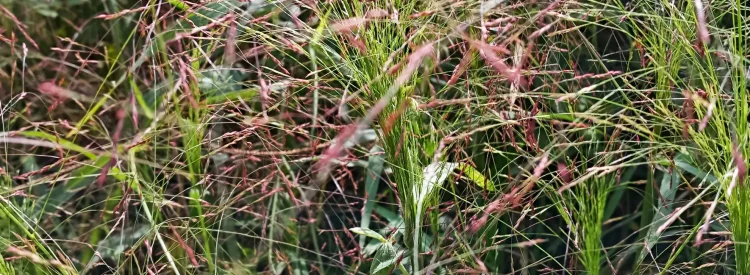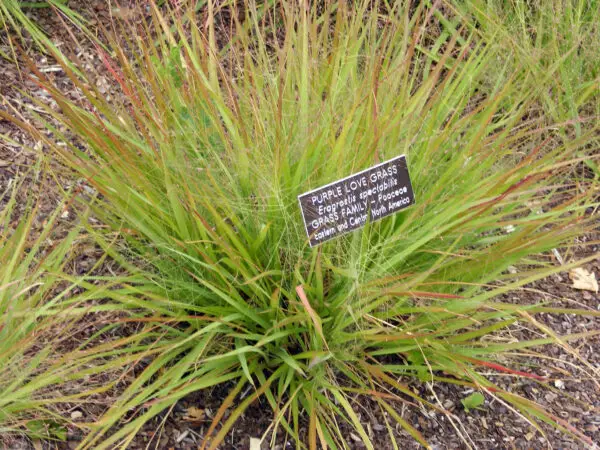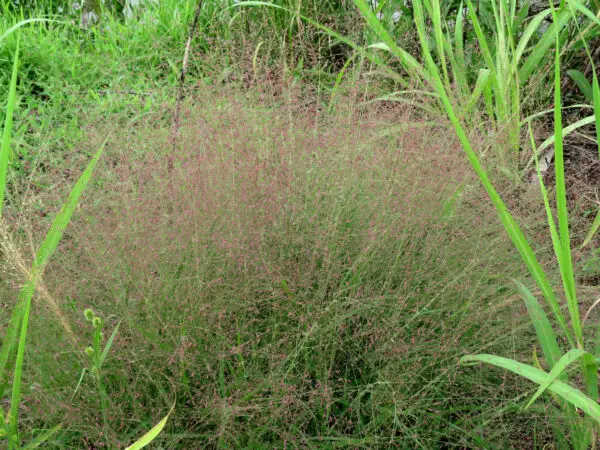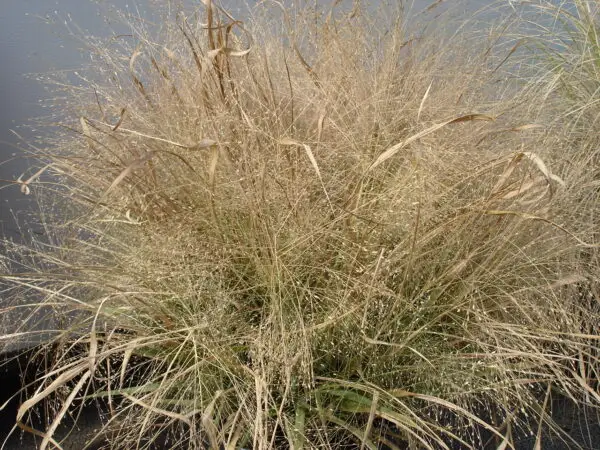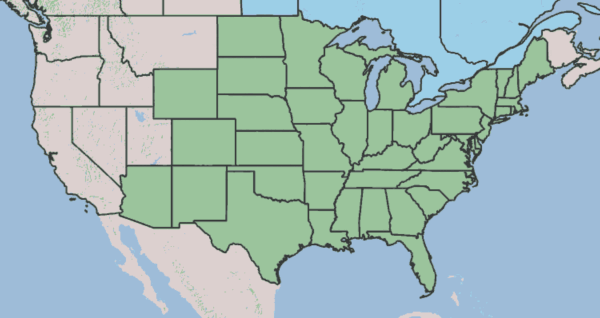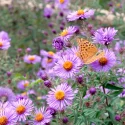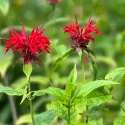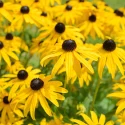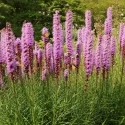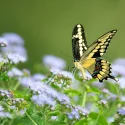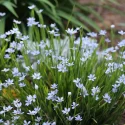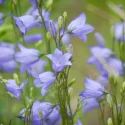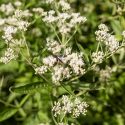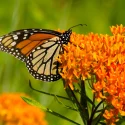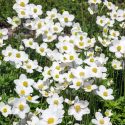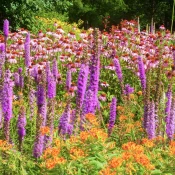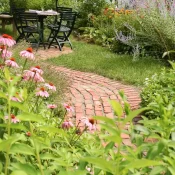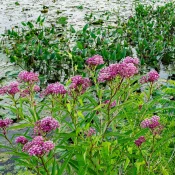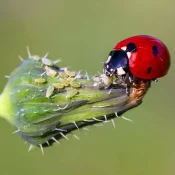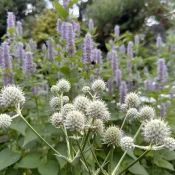Purple Lovegrass is proof that native grasses can be just as show-stopping as flowers. With its airy, purple-pink seed heads that shimmer in the late summer sun, this warm-season grass adds a dreamy, hazy effect to gardens, roadsides, and meadows.
But Purple Lovegrass isn’t just about good looks—it’s a tough, drought-tolerant native that thrives in poor soils, needs little maintenance, and supports pollinators and wildlife. Let’s dig into why this underrated grass deserves a spot in your garden.
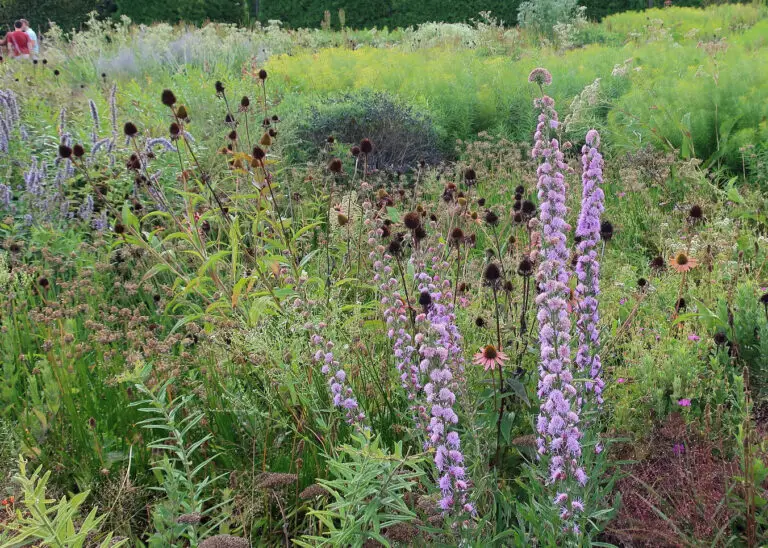
Purple Lovegrass has an absolutely beautiful name and offers fuss-free beauty for 60% of United States gardens.
Before we dig into how to plant, let’s discuss what it delivers.
What are the benefits of planting Purple Lovegrass?
Planting Purple Lovegrass has many benefits, including:
- Low-Maintenance Beauty: Thrives in poor soils, needs little watering, and doesn’t require fertilizer.
- Drought-Tolerant: Once established, this native grass can handle heat and dry spells like a pro.
- Erosion Control: Its fibrous root system helps stabilize soil, making it a great choice for slopes or sandy areas.
- Seasonal Cinematic Interest: The feathery purple-pink seed heads appear in late summer and create a striking effect when backlit by the sun. In fall, the grass turns a warm copper-bronze.
When we say this plant is tough, we mean it
Purple Lovegrass thrives in difficult situations and thrives with neglect. Once established, its deep root system ensures it will survive the toughest dry spells.
Don’t just take it from The Plant Native—Virginia Cooperative Extension includes it in Tried and True Native Plant Selections for the Mid-Atlantic, and the Native Plant Trust says it plainly: “Purple lovegrass is a tough plant for tough places.”
Purple Lovegrass through the seasons
This plant changes itself dramatically throughout the year. Here’s what you can expect:
Late Spring + Summer
Purple Lovegrass is a warm-season grass, meaning it grows when the soil temperatures are above 60. When the temp hits this number, expect to see fresh green leaves burst from its roots. (Whenever the soil is colder than this, it’s dormant.)
Late Summer into Fall
This is the season when Purple Lovegrass shines. Watch its seed-filled tips slowly change into soft hues of pink and purple. To keep its color visible, plant this native gem in borders, in front of gardens, or on walkways.
Late Fall / Winter
Let Purple Lovegrass stand through the winter—its seeds provide food for songbirds, and its fading greenery turns a warm, golden bronze. Keeping native grasses in place during the colder months helps support wildlife when resources are scarce. Plus, those delicate seed heads catching the frost? A winter garden win.
And then it’s time to start the cinematic changes all over again in the spring!
Maybe you’ve never heard of this native grass before visiting this article. It was new to us, too. Purple Lovegrass was put on The Plant Native’s radar thanks to the expertise of Kelly and Emilie, the Co-Executive Directors of Chesapeake Natives. You can read more about their recommendations in our interview:
Some of you might be thinking hmm…Purple Lovegrass reminds me of another pink-hued grass—Purple Muhly Grass.
And now you’re probably asking:
What’s the difference between Purple Lovegrass and Pink Muhly Grass?
The differences are somewhat easy to see when you put the two native grasses side by side:
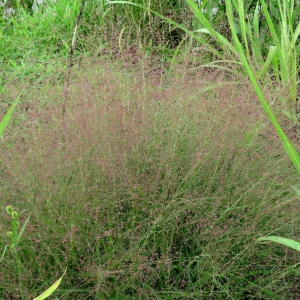
Purple Lovegrass
- Short: 1-2 feet tall
- More airy, open grass
- Cinematic beauty: Green in spring, color in late summer into fall, bronze after
- Drought-tolerant
- Salt-tolerant: Ok to plant near roads
- Great name: Lovegrass is a great common name (read our Beautiful Plants, Terrible Names to read some bad ones)
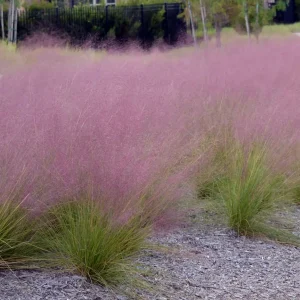
Purple Muhly Grass
- A little taller: 2-4 feet tall
- More clumped grass
- Cinematic beauty: Green in spring, color in late summer into fall, bronze after
- Drought-tolerant
- Salt-tolerant: Ok to plant near roads
- Terrible name: Who or what is MUHLY? Read our Purple Muhly Grass profile to find out.
Both of these grasses also have huge native ranges. Purple Lovegrass is native to more than half of the United States.
Where is Purple Lovegrass native?
Purple Lovegrass is native to half of North America and includes the Northeast, Mid-Atlantic, Midwest, and Southern United States.
Where can I find Purple Lovegrass?
We are not going to lie—finding a specific native plant can be a challenge. But it’s much easier if you know where to look!
We’ve assembled four ways to easily source Purple Lovegrass:
Where can I find seeds and plants?
Finding native plants can be challenging (we partly blame Marie Antoinette.) To make it easier, we’ve assembled four sourcing ideas.
300+ native nurseries make finding one a breeze
Explore 100+ native-friendly eCommerce sites
Every state and province has a native plant society; find yours
Online Communities
Local Facebook groups are a great plant source
What are good pairings for Purple Lovegrass?
A great rule of thumb when planting a garden is to pick native plants that bloom from spring to fall, so that pollinators always have a treat. Since amsonias are spring bloomers, pick some other great natives that bloom in the summer and fall to plant alongside. Some ideas include:
Native plants for the summer
That concludes our introduction to Purple Lovegrass. This native grass has lots to offer, from springtime greenery to purple-tipped summer hues and warm bronze foilage in the fall and winter. Since it’s a perennial, plant once and watch it come back year after year. Its long root system ensures it is drought-tolerant, keeping your water bills low. Looking for other planting ideas? Visit our regional guides for Northeast, Midwest, Mid-Atlantic, or Southern gardens. Or go meet its purple-grass cousin, Purple Muhly Grass. Happy planting!
Sources
- Ncsu.edu. “Eragrostis Spectabilis (Purple Lovegrass, Purple Love Grass, Tumble Grass).” North Carolina Extension Gardener Plant Toolbox, 2025.
- United States Department of Agriculture. “Purple Lovegrass Plant Fact Sheet.” PDF, n.d.
- Wildflower.org. “Purple Lovegrass.” Lady Bird Johnson Wildflower Center – the University of Texas at Austin, 2025.
- Master Gardeners of Northern Virginia. “Eragrostis Spectabilis (Purple Lovegrass, Tumblegrass),” February 15, 2020.
- Native Plant Trust. “Eragrostis Spectabilis.” New England Wild Flower Society, 2020.
- Umd.edu. “Ornamental and Native Grasses for the Landscape” University of Maryland Extension, 2024.
What if your feed was actually good for your mental health?
Give your algorithm a breath of fresh air and follow us.
